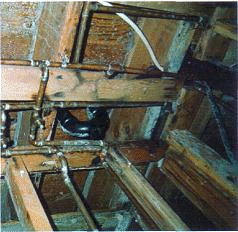 The mold (or mould, in the Queen’s English) has been the victim of a bad press. Mention the word and it conjures up an image of something rotting or in the process of decomposition. And yet, were it not for the mold that inspired the discovery of penicillin millions of lives would have been lost. If you love cheese, wines such as Auslese, Sauternes and Tokaji or the protein rich meat-like product called quorn, you can thank the mold for that, too. The mold is a network of thread-like filaments. Some molds are good, some are bad. Some of the undesirable types of mold grow in the indoor environment. Apart from being a potential health hazard, indoor mold is unsightly. You usually find them in damp sections of the building such as the attic or basement, or in the kitchen and bathroom. The mold is also likely to raise its unsightly presence in parts of the home that have been flooded or have poor ventilation.
The mold (or mould, in the Queen’s English) has been the victim of a bad press. Mention the word and it conjures up an image of something rotting or in the process of decomposition. And yet, were it not for the mold that inspired the discovery of penicillin millions of lives would have been lost. If you love cheese, wines such as Auslese, Sauternes and Tokaji or the protein rich meat-like product called quorn, you can thank the mold for that, too. The mold is a network of thread-like filaments. Some molds are good, some are bad. Some of the undesirable types of mold grow in the indoor environment. Apart from being a potential health hazard, indoor mold is unsightly. You usually find them in damp sections of the building such as the attic or basement, or in the kitchen and bathroom. The mold is also likely to raise its unsightly presence in parts of the home that have been flooded or have poor ventilation.
Indoor mold is a health hazard
The indoor mold can cause health problems, especially with those suffering from asthma. A greenish-black, slimy variety known as Stachybotrys chartarum has earned the name “toxic mold” and grows on wet organic material rich in cellulose such as wood or paper (but not on concrete or tile). It may cause severe problems for humans as well as pets, and is one of the causes of “sick building syndrome”. This indoor mold can produce allergic reactions like watery eyes, headaches, frequent sneezing and coughing.
Indoor mold is an early warning device
The upside is that an indoor mold can serve as an early warning device. It tells you that an area of the home is not properly ventilated, has excess moisture and that the air quality is inferior. You can then take steps to reduce moisture in the area and remove materials that cause mold growth.
Cleaning up indoor mold
The mold is everywhere and can survive under all sorts of conditions, even in places like the refrigerator. Some molds are resistant to anti-fungal soap or highly-acidic solvents. Therefore, when cleaning up a mold-infested area, you should always wear proper protection like a respirator mask, rubber gloves and the right clothing.
The key to cleaning up an area with indoor mold is to solve the moisture problem. Dry up the excess moisture and remove all the materials that have been infested by the mold. Get rid of items like carpets and wallpaper that cannot be cleaned and dried. First spray the area with water to keep down the dust and debris while you are removing the items. The materials should then be sealed in a double-bag and the bag wiped clean to prevent the mold from spreading to other areas.
If the area with indoor mold cannot be removed, it should be cleaned with soap or detergent. After that, it helps to disinfect the area with a diluted bleach solution (care should be taken when using bleach. It is a hazard too). Do not sand or scrape the surfaces and avoid using a hammer to remove drywall that is mold-infested.
If the affected area is larger than 10 square feet, you may need to turn the job over to a professional mold remediator. You can find companies that specialize in restoring homes damaged by fire and water whose services include indoor mold remediation.
If you would like to receive more information regarding our laboratory services or our prices, please call us at 905-290-9101 (Ontario). You can also complete the form below and we shall get back to you within 2 business days.